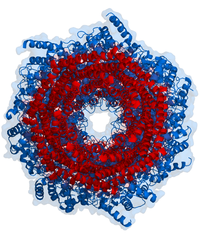
Photo from wikipedia
Much of cellular activity is mediated by large multisubunit complexes. However, many of these complexes are too complicated to assemble spontaneously. Instead, their biogenesis is facilitated by dedicated chaperone proteins,… Click to show full abstract
Much of cellular activity is mediated by large multisubunit complexes. However, many of these complexes are too complicated to assemble spontaneously. Instead, their biogenesis is facilitated by dedicated chaperone proteins, which are themselves excluded from the final product. This is the case for the proteasome, a ubiquitous and highly conserved cellular regulator that mediates most selective intracellular protein degradation in eukaryotes. The proteasome consists of two subcomplexes: the core particle (CP), where proteolysis occurs, and the regulatory particle (RP), which controls substrate access to the CP. Ten chaperones function in proteasome biogenesis. Here, we review the pathway of CP biogenesis, which requires five of these chaperones and proceeds through a highly ordered multistep pathway. We focus on recent advances in our understanding of CP assembly, with an emphasis on structural insights. This pathway of CP biogenesis represents one of the most dramatic examples of chaperone-mediated assembly and provides a paradigm for understanding how large multisubunit complexes can be produced.
Journal Title: Journal of cell science
Year Published: 2022
Link to full text (if available)
Share on Social Media: Sign Up to like & get
recommendations!